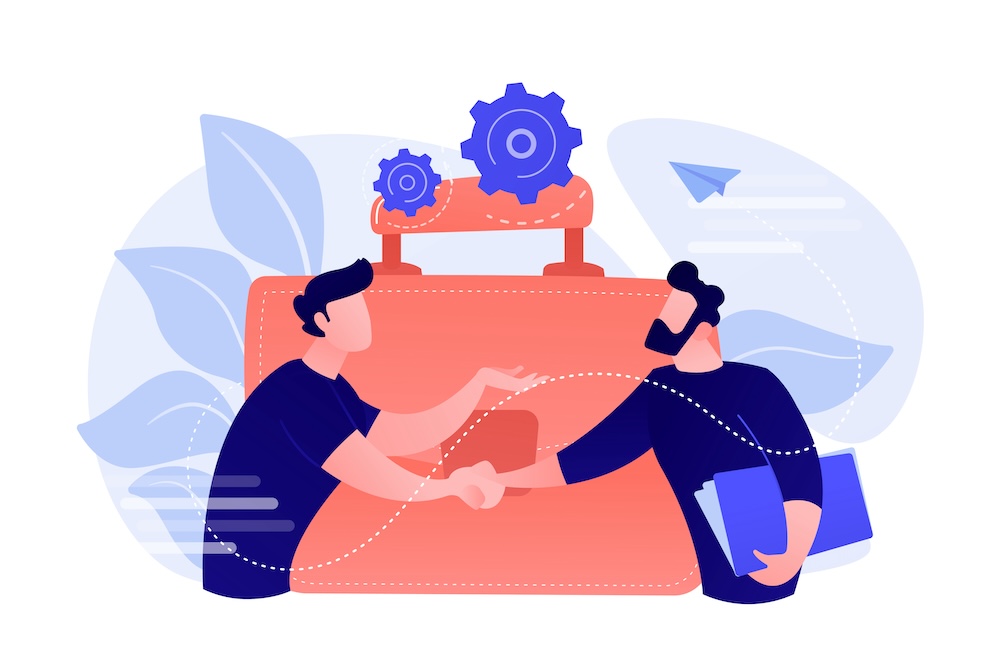
Everybody in sales deals with it, but nobody likes thinking about it too much — or often even acknowledging it exists. Yep, you guessed it. We’re talking about lost customers. As much as they might wish it weren’t the case, even the most successful sales teams deal with customer churn.
There’s simply no way to avoid it. Losing customers is an inevitable challenge that all companies have to deal with, and how they respond to it can often be what separates good organizations from great ones.
Where Does Customer Churn Come From?
Customer churn can come about from a number of different factors. Competitive pressures are probably the most impactful. Every business has competitors, and sometimes, those companies fighting for your market share just manage to get a bit of an edge over you in certain areas.
That’s normal, and certainly no cause for mass panic, but it is a reality of the modern business environment. More problematic reasons for losing customers include dissatisfaction with the products or services you’re selling, which may indicate that larger structural changes need to take place. Or sometimes the customers themselves develop different needs, which is another challenge altogether.
Whatever the reason for losing customers, however, you don’t have to simply sit around and accept that it’s happening. Being able to re-engage and reconvert lost customers can be an enormous difference-maker when it comes to long-term profitability and sustainable sales growth.
Let’s take a closer look at the question of how to re-engage lost customers, focusing on a few different strategies that can be employed to recapture that revenue and get your sales engine back on the right track.
Developing a Customer Re-Engagement Strategy
No two businesses are alike, even when they’re in the same industry or serving the same segment of the market. So when it comes to the question of figuring out what strategy to employ, there’s no such thing as a one-size-fits-all solution.
As with so many topics in the world of sales, the right choice is going to depend on a range of business-specific factors. It can be easy to fall into the trap of looking for a silver bullet — some kind of plug-and-play solution that’ll sort out all the issues with your customer churn without requiring any further oversight from your end.
Unfortunately, that perfect, widely applicable strategy doesn’t exist. But what you can do is understand the fundamental building blocks of customer re-engagement strategies in order to craft your own process, tailored to your business’s unique needs.
Let’s examine how you might go about developing an effective customer re-engagement strategy in order to mitigate the damaging impact of lost customers and keep your growth trending in the right direction.
1. Identifying and Segmenting Lost Customers
The modern business world runs on data. Any company that’s trying to make concrete, long-term choices without backing those decisions up with cold, hard information is in for a rocky road. And when we talk about how to claw back any lost customers, data plays a vitally important role right from the word ‘go’.
The first step to developing a sustainable customer re-engagement strategy is figuring out who the lost customers actually are and segmenting them accordingly. After all, without a clear picture of who you’re trying to target, you won’t have much, if any success, in engaging them.
Identifying the lost customers is easy enough, and can be assisted by using the business data your organization has stored in its CRM or similar tools. And when it comes to dividing that group into specific segments, the best strategy is to use a few different criteria.
Reasons for Churn
By far the most important differentiating factor you should consider is the actual reason for the churn. A customer leaving your company to go straight to a competitor is hugely different in psychological terms to a client who’s decided they don’t need your products at all, for example.
The reasons underpinning customer churn aren’t always immediately apparent, but there are a couple strategies you can employ. Analyzing feedback is your best bet here: there’s no more reliable source of truth than the customer themselves, after all. noCRM provides integrations with form tools like Typeform and JotForm to streamline the feedback collection process, helping you gather the insights you need at scale without getting bogged down in a dozen different tools, surveys, and forms.
In addition to feedback, it’s always good to take a closer look at the sales data itself. noCRM can help out here as well, by offering a comprehensive suite of sales statistics features sales managers can use in order to understand their team’s performance. With detailed insights into everything from pipeline and lead performance to sales forecasts and data on past leads, you can dive deep and figure out where you’re losing your customers in order to segment them accordingly. To learn more about noCRM’s statistics suite, click here!
Customer Value
Once you’ve got a clearer picture of why you lost those customers, it’s a good idea to further break them up based on their value to your business. Not all customers are created equal, after all — some produce much more revenue than others.
Given that the issue of customer churn is such a broad challenge, it’s important that you dedicate most of your resources to re-engaging the highest-priority customers, i.e. those that will provide the most value to your organization.
Behavioral Insights
You can also use behavioral insight data to divide the segments up even more specifically. Past interactions and purchase history can be great sources of wisdom to draw from as you set about designing re-engagement approaches.
2. Personalization and Customization
The best re-engagement efforts are as personalized as possible. To understand why, think about the problem from a high-level perspective. You’ve lost these customers because something went wrong, somewhere along the line. If you waste your chance to rebuild trust with your company by sending them generic content or failing to speak to their pain points, your campaigns just aren’t going to be as effective as you need them to be.
By this point, you should hopefully have several different lost customer segments defined and organized. So now it’s time to start reaching out to them. There are a few different approaches you can employ here, either separately or as part of a wider, more cohesive effort:
Personalized Communication
Send your lost customers personal messages that address specific concerns or their reasons for leaving. The key to success with this strategy lies in being as precise as possible. This isn’t the time for vagueness. Rather, you want to get directly to the heart of the matter and prove that you’ve taken the time to understand their situation.
Customized Offers
Another great way to re-engage lost customers is to give them a reason to pay attention to your business again. That’s where customized offers come into play. By providing incentives such as discounts, special promotions, or exclusive access to certain products or services, you can make them feel valued while simultaneously boosting their interest in your company.
For the best results, tailor these offers according to data you’ve analyzed on their previous behavior.
3. Utilizing Multi-Channel Communication
Given that you’re going to be getting in touch with a large number of past customers, it’s important that you consider expanding your reach as much as possible in order to boost the chances of one of the messages getting through. Multi-channel communication is the perfect way to get wide with your outreach, since it gives you the unique opportunity to get in touch with those lost customers in various different places and contexts.
As a general rule, the more channels you can effectively target a churned customer through, the better your chances of re-engaging them. An important caveat to consider, though, is that the quality needs to be equally high across every medium you’re using.
Bad content is worse than no content, and if your marketing team can’t keep up the required level across every channel, it’s best to focus on doing one or two really well instead.
Email Campaigns
Emails are a great way to get in touch because they’re low impact, they’re not intrusive, and there’s already a certain level of psychological acceptance involved. Today’s consumers are used to getting offers and personalized messages in the form of emails, after all — it won’t stand out as being too aggressive.
Make sure to use compelling subject lines and as much personalized, dynamic content as possible to boost your likelihood of success.

Social Media
The biggest benefit of using social media to engage lost customers is that you can afford to be much more direct and personal. Utilize the platforms your customers are active on in order to share updates, spread the word about new promotions, and engage in dialogue to rebuild that connection with your business. Don’t make the mistake of pushing it too hard, though: nobody wants to be pestered on Instagram or X (Twitter).

Direct Outreach
Direct outreach is a lot more labor-intensive than email campaigns or social media, but it’s probably the most potent of the lot in terms of actual success rates. By personally calling lost customers or sending personalized messages at the individual scale, you’ll be demonstrating genuine interest in those customers and true commitment to addressing their concerns.

It’s time-consuming, though, and not everybody might have consented to being called, so don’t forget to double-check the permissions involved with any data agreements between you and your past customers.
Improving the Customer Experience
Although it’s not technically a strategy for re-engaging lost customers, we’re going to include a brief word on improving the customer experience because it can help cut down on customer churn rates going forward. It’s always a good idea to be striving for constant improvement, no matter how successful your business is. Taking the feedback you’ve gathered from trying to re-engage lost customers and using it to rethink certain elements of your sales engine is a surefire way to make sure you don’t lose any more than you have to moving forward. After all, you can always re-engage lost customers, but the ideal scenario is never losing them in the first place!
Customer re-engagement isn’t just about recovering lost revenue — it’s about revitalizing relationships and fostering long-term loyalty. Any effective re-engagement strategy has to begin with thoroughly understanding your lost customers so you can then employ the appropriate techniques for getting them back onto the right path.
And that’s exactly where noCRM is particularly helpful, by providing integrations with feedback-gathering forms like Typeform and JotForm, as well as a comprehensive sales statistics suite for deeper analysis. If you’ve been struggling with lost customers and would like to deal with the problem more efficiently, why not try noCRM today? It might just make the difference you’ve been looking for!


